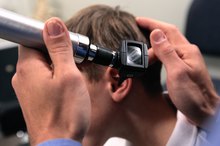How to Boost Your Alpha Brain Waves (and Why You Should Care)
Wanna know something cool?
Your brain is made up of billions of brain cells called neurons, which use electricity to communicate with each other. The combination of millions of neurons sending signals all at once produces an enormous amount of electrical activity in the brain, which can be detected using sensitive medical equipment like an electroencephalography (EEG) machine.
These are what we refer to as brainwaves. The different types of brainwaves are categorized as:
- Beta: emitted when we are consciously alert, or we feel agitated, tense, afraid
- Alpha: emitted when we're in a state of physical and mental relaxation, although aware of what's happening around us
- Theta: a state of sleepiness or drowsiness with reduced consciousness
- Delta: emitted when we're unconsciousness or in deep sleep
Read more: 8 Ways to Keep Your Brain Sharp as You Age
What Are Alpha Brain Waves?
Alpha brain waves are a sign of relaxed activity in your brain. If you've ever practiced meditation, yoga or even felt relaxed after a glass (or two) of wine, you've experienced alpha brain waves.
This state produces the ideal conditions to learn new information, keep fact, data, perform elaborate tasks, learn languages and analyze complex situations. That's because your brain produces more beta-endorphin, noroepinephrine and dopamine — hormones linked to memory formation and feelings of mental clarity.
- Alpha brain waves are a sign of relaxed activity in your brain.
- If you've ever practiced meditation of wine, you've experienced alpha brain waves.
Benefits of Alpha Brain Waves
This Song Can Stop Your Anxiety in 8 Minutes
Learn More
Stress Reduction: Your brain’s thinking is slower, your mind is clear and you may even feel slightly drowsy. Your body has zero stress, tension, anxiety or other feelings of being nervous. Increasing your alpha brain wave activity is a profound way to reduce your stress.
Optimized Athletic Performance: There's evidence that just before a golfer hits their best shot or a basketball player sinks a shot (think LeBron and Kobe), alpha activity bursts in the left-hemisphere of their brain. Basically, it can help put you “in the zone.”
Improved Immune Function: Your alpha waves are responsible for amping up your immune system. Stress can quickly ramp up damage to your immune system, but taking time to relax will help increase alpha activity.
Natural Antidepressant: Alpha brain waves allow for increased release of an important neurotransmitter called serotonin, which can help combat depression.
Creativity Boost: If you consider yourself to have above-average creativity, chances are that you often experience an alpha brain wave state. Conversely, if you feel that your creativity is lacking, an increase in your alpha waves will feel great.
Enhanced Problem Solving: Alpha waves integrate both hemispheres of your brain for better communication and clearer thinking. You certainly won’t feel mentally “stuck” in the alpha state.
Read more: How to Be More Creative in 9 Easy Steps
- Stress Reduction: Your brain’s thinking is slower, your mind is clear and you may even feel slightly drowsy.
- Conversely, if you feel that your creativity is lacking, an increase in your alpha waves will feel great.
Techniques to Increase Alpha Brain Waves
So how do you get into this "flow state"? Here are a few exercises you can do to boost your alpha brain wave activity.
Meditation
Deep Breathing Meditation Technique
Learn More
Meditation will get you into the alpha brainwave state fairly quickly after some practice (provided you know what you're doing).
If you make meditation a daily practice or start up a routine, you will be able to tap into that alpha state. The nice thing about meditation is that it’s free and very effective.
There are many forms of meditation.
Over the last decade, transcendental meditation (TM), based on Hindu teaching, has become popular in the West. A mantra or sound is given to the meditator by a teacher, which is then repeated over and over with eyes closed.
- Meditation will get you into the alpha brainwave state fairly quickly after some practice (provided you know what you're doing).
- If you make meditation a daily practice or start up a routine, you will be able to tap into that alpha state.
Closed-Eyes Visualization
Every time you close your eyes and attempt to visualize, your alpha brain waves increase profoundly. If you're able to focus on pictures in your mind or using your imagination to create pictures, you can access alpha brain waves.
Some types of Hindu and Buddhist practices focus on a mandala — a representation of an object like a thousand-petal lotus.
Regardless of their origin, all the meditative techniques have at least two phases.
The first is to quiet the body, and the second is to quiet the mind. This is often done in the following sequence:
- Relax the motor muscles (ex.
muscles in arms and legs).
- Decrease the breathing rate. 3. Decrease the rate of other body functions. 4. Slow brain activities.
A simple easy to learn meditative exercise, which combines both a mantra and a mandala, is described as follows:
- Find a quiet place where you can be alone. 2. Sit in a comfortable position. 3. Close your eyes and take three deep breaths.
Let your thoughts come and go.
4.
Start to visualize a particular object (ex. a rose). 5. In your mind, start to repeat the word for the object over and over at any speed or rhythm. 6. As you continue to repeat the word, start to imagine the rose opening and closing in the same rhythm. 7. Keep this process going for two to 20 minutes. 8. When it's time to stop, open your eyes slowly.
You should feel relaxed, refreshed, and less anxious after trying this technique.
- Every time you close your eyes and attempt to visualize, your alpha brain waves increase profoundly.
- Relax the motor muscles (ex.
- In your mind, start to repeat the word for the object over and over at any speed or rhythm.
Deep-Breathing Exercises
A common breathing technique that can be done while in the Lotus position (sitting on the floor with the feet tucked under the knees), is as follows:
- Sit comfortably in Lotus pose.
- Breathe in through your mouth for a count of six.
- Hold your breath as you count to nine.
- Exhale through your mouth for a count of three. 5.
Repeat this three times. 6. Do this whole sequence breathing in through the mouth and out through the nose. 7. Repeat the sequence for three rounds while holding the left nostril closed with a finger. 8. Do the same with the right nostril closed.
These breathing exercises can then be done in the various yoga positions. After engaging in this activity, many find that they feel relaxed and are energized, alert and calm.
Read more: 17 Exercises That Challenge Your Body and Brain
- A common breathing technique, is as follows: 1.
- Exhale through your mouth for a count of three.
Other Forms of Exercise That Increase Alpha Wave Activity
Though you might assume high-intensity physical activities like running, cycling and dancing would put you in a keyed-up state, about 90 minutes after a good workout, a feeling of deep relaxation occurs.
To reap the most benefits, aim to exercise at least three times a week for at least 20 minutes each time. Here are your best bets:
- Running, jogging and fast walking
- Swimming and biking
- Dancing
- Tai Chi
- Self-defense (Karate, Taekwondo and other martial arts)
Related Articles
References
- University of Indiana: Stress and Stress Reduction
- Scientific American: What is the Function of the Various Brainwaves?
- MIT: The Dalai Lama Center for Ethics: The Benefits of Meditation
- Psychology Today 2015. Alpha Brain Waves Boost Creativity and Reduce Depression.
- Sacchet MD, Laplante RA, Wan Q, et al. Attention Drives Synchronization of Alpha and Beta Rhythms between Right Inferior Frontal and Primary Sensory Neocortex. J Neurosci. 2015 Feb 4;35(5):2074-82. doi:10.1523/JNEUROSCI.1292-14.2015
Writer Bio
Ashley Miller is a licensed social worker, psychotherapist, certified Reiki practitioner, yoga enthusiast and aromatherapist. She has also worked as an employee assistance program counselor and a substance-abuse professional. Miller holds a Master of Social Work and has extensive training in mental health diagnosis, as well as child and adolescent psychotherapy. She also has a bachelor's degree in music.









